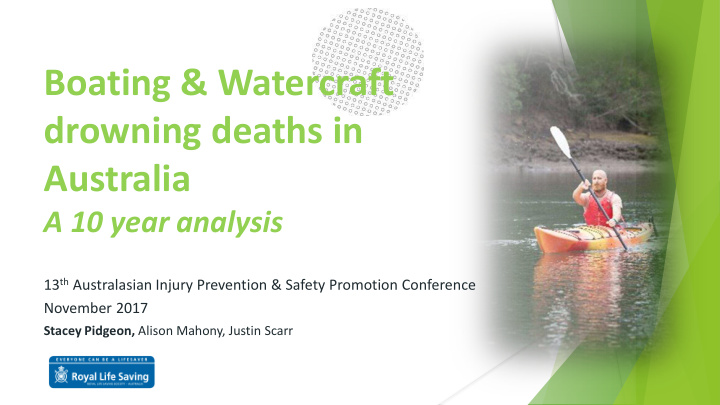



Boating & Watercraft drowning deaths in Australia A 10 year analysis 13 th Australasian Injury Prevention & Safety Promotion Conference November 2017 Stacey Pidgeon, Alison Mahony, Justin Scarr
Australian Water Safety Strategy 2016 - 2020 Goal 9: Reduce boating, watercraft and recreational activity related drowning deaths Increase access to drowning prevention education and skills i. for recreational boaters and watercraft users ii. Advocate for best practice in policy, legislation enforcement and promotion of lifejacket use iii. Conduct research into boating and watercraft-related drowning incidents which assists identification of risk factors and prevention strategies for drowning
Aims To investigate boating & watercraft-related drowning deaths in Australia between 1 July 2005 to 30 June 2015. Develop an increased understanding of the contributing factors of boating and watercraft- related drowning deaths. Provide recommendations to support new and existing drowning prevention strategies.
Methods Only unintentional drowning deaths whilst participating in boating and watercraft-related activity were included Sourced from National Coronial Information System Definitions as per the Australian Water Safety Strategy 2016-2020 Boat Powered vessels e.g. motor boats, jet skis, sail boats, yachts, catamarans, passenger ferries, cruise ships, commercial vessels Watercraft Non powered recreational equipment that can be rowed or paddled e.g. kayaks, canoes, surf skis, surf boards, body boards, inflatable rafts/objects, any boat without a motor, stand up paddle board, kite surfing
Key Findings 473 over 10 years 71.5% boating, 28.5% watercraft 50 47 45 41 39 40 33 34 33 35 30 30 30 26 25 25 20 20 17 16 15 15 14 11 15 9 10 8 10 5 0 2005-2006 2006-2007 2007-2008 2008-2009 2009-2010 2010-2011 2011-2012 2012-2013 2013-2014 2014-2015 Boating Watercraft Linear (Boating) Linear (Watercraft)
Who? 92% Men 100 88 90 82 81 80 75 70 61 60 50 36 40 29 30 20 7 6 10 4 4 0 0-4yr 5-9yr 10-14yr 15-17yr 18-24yr 25-34yr 35-44yr 45-54yr 55-64yr 65-74yr 75+ Age
Remoteness & Visitor Status Overseas 133 Unknown 140 visitor 128 3% 5% Interstate visitor 114 120 8% 100 80 Intrastate Not a visitor 21% visitor 60 49 63% 33 40 20 12 4 0 Major Outer Inner Remote Very Offshore Unknown cities regional regional remote Remoteness classification of incident postcode
Activity & Location Lake/Dam/Lagoon 10% 140 132 127 120 Beach 15% 100 Ocean/Harbour 53% 80 River/Creek/ Stream 58 22% 60 38 37 40 19 16 20 13 12 7 7 5 2 0 Activity prior to drowning
Key risk factors Alcohol Alcohol present 26.2% involved alcohol 58.8% ≥0.05% Under Drugs 41% Over 30.6% drugs present 0.05 59% 31.3% illegal BAC ≥0.05% 69% Boaters vs. 25% Watercraft users
Key risk factors cont. Multiple fatality event Lifejacket status 5 164 400 352 0 350 300 5 250 0 200 75 54 150 108 50 39 100 25 50 13 0 0 No Yes Irrelevant (surfing, Yes No Unknown body boarding etc.)
Emerging issues Older people Rural and remote locations Local residents vs. being a visitor to the drowning location Increase of drug taking and boating Increase of deaths when using watercraft-related drowning deaths vs. powered boats
Recommendations To address drugs and boating Increased enforcement of random drug testing, especially in regional areas Agencies to promote the consequences of mixing drugs (incld. medication), alcohol and boating Encourage people to manage their medication and be aware of side effects
Recommendations In Rural and Remote areas Installation of personal rescue equipment at boat ramps Agencies to develop and promote strategies for communications e.g. use of VHF radios, personal response beacons For Older Adults Encourage medical checks on a regular basis Agencies should consider developing specific programs or refresher courses for this population
Challenges for the future… Ability to adapt and respond to these new issues whilst continuing to address key factors such as lifejackets Sector collaboration to ensure safety messages are consistent and relevant Application of research to policy and practice at the community level
QUESTIONS? Thank You Stacey Pidgeon spidgeon@rlssa.org.au www.Royallifesaving.com.au
Recommend
More recommend